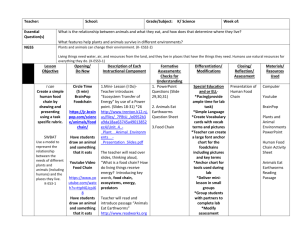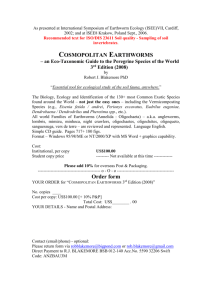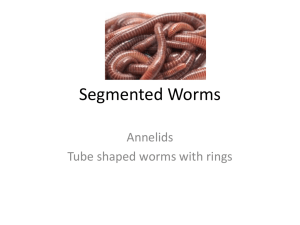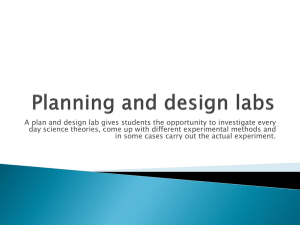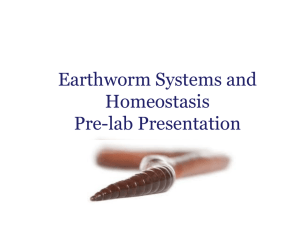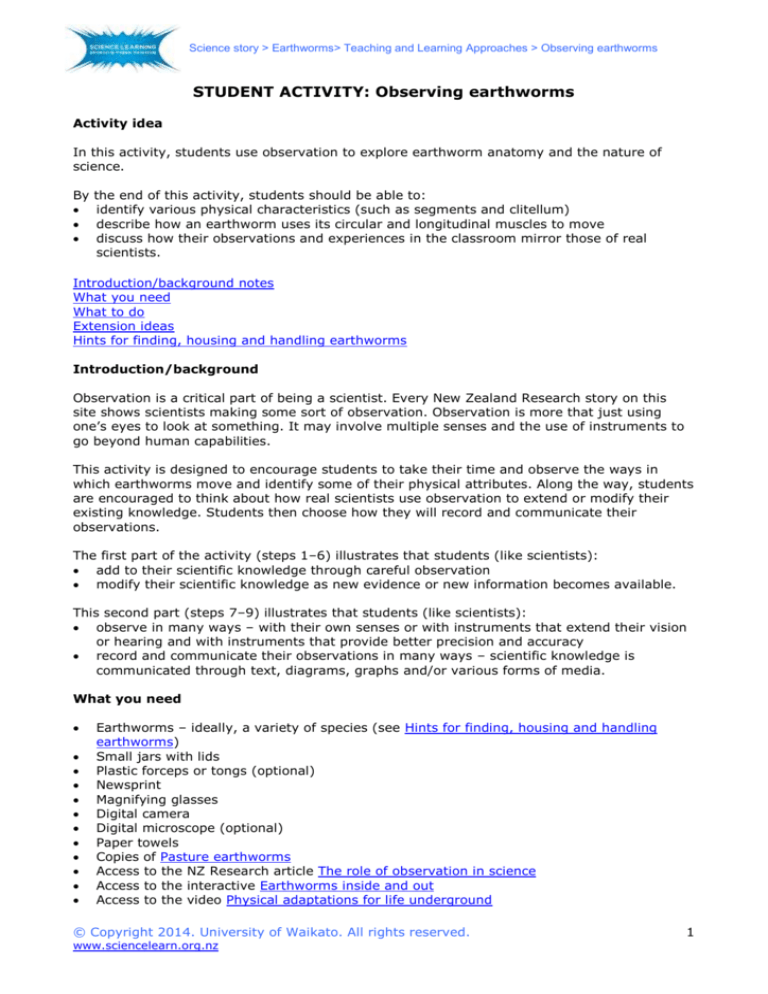
Science story > Earthworms> Teaching and Learning Approaches > Observing earthworms
STUDENT ACTIVITY: Observing earthworms
Activity idea
In this activity, students use observation to explore earthworm anatomy and the nature of
science.
By
the end of this activity, students should be able to:
identify various physical characteristics (such as segments and clitellum)
describe how an earthworm uses its circular and longitudinal muscles to move
discuss how their observations and experiences in the classroom mirror those of real
scientists.
Introduction/background notes
What you need
What to do
Extension ideas
Hints for finding, housing and handling earthworms
Introduction/background
Observation is a critical part of being a scientist. Every New Zealand Research story on this
site shows scientists making some sort of observation. Observation is more that just using
one’s eyes to look at something. It may involve multiple senses and the use of instruments to
go beyond human capabilities.
This activity is designed to encourage students to take their time and observe the ways in
which earthworms move and identify some of their physical attributes. Along the way, students
are encouraged to think about how real scientists use observation to extend or modify their
existing knowledge. Students then choose how they will record and communicate their
observations.
The first part of the activity (steps 1–6) illustrates that students (like scientists):
add to their scientific knowledge through careful observation
modify their scientific knowledge as new evidence or new information becomes available.
This second part (steps 7–9) illustrates that students (like scientists):
observe in many ways – with their own senses or with instruments that extend their vision
or hearing and with instruments that provide better precision and accuracy
record and communicate their observations in many ways – scientific knowledge is
communicated through text, diagrams, graphs and/or various forms of media.
What you need
Earthworms – ideally, a variety of species (see Hints for finding, housing and handling
earthworms)
Small jars with lids
Plastic forceps or tongs (optional)
Newsprint
Magnifying glasses
Digital camera
Digital microscope (optional)
Paper towels
Copies of Pasture earthworms
Access to the NZ Research article The role of observation in science
Access to the interactive Earthworms inside and out
Access to the video Physical adaptations for life underground
© Copyright 2014. University of Waikato. All rights reserved.
www.sciencelearn.org.nz
1
Science story > Earthworms> Teaching and Learning Approaches > Observing earthworms
What to do
1. In pairs, students observe earthworms for a few minutes, jotting down notes about what
they’ve observed. Groups feed back to make a class list.
2. As a class, watch the video clip Physical adaptations for life underground, use the
interactive Earthworms inside and out and read the Pasture earthworms brochure.
3. Discuss any scientific terminology that may be new or unknown.
4. Have students observe the earthworms a second time, adding to their initial observation
notes.
5. As a class, discuss any changes students made to their initial observations. Did having
additional information from the video or interactive change the way they made their
observations or recorded their information?
6. Explain that this is how scientists work. They build their science knowledge through
observation, with information from books or journals and discussions with the scientific
community. When new evidence becomes available, scientists test it and, with time, may
modify existing science knowledge. These changes are often very small.
7. Once students have observed earthworms with the naked eye and have had the
opportunity to feel for setae (see Hints for finding, housing and handling earthworms), ask
them to brainstorm other methods of observation. Some options include:
hand lenses
digital cameras
digital microscopes
video cameras
student/class handheld devices with photo or video capability.
8. Discuss how students can use these methods to record or report their observations and
findings. Some options include:
placing magnified images on an IWB or tablet device and using annotation tools to label
anatomy or describe anatomical functions
video with a written or spoken voiceover
PowerPoint or similar presentation tool with photos and text
traditional observational drawings
two-word poems to describe visual and touch sensations, accompanied by a photo or
detailed drawing (see Extension ideas).
9. Refer to the NZ Research article The role of observation in science.
Discuss the techniques Dr Nicole Schon and Dr Trish Fraser use while observing
earthworms. (Hand sorting and counting, CAT scanning.)
Discuss how this compares to techniques students have used. (Nicole uses visual
identification; Trish uses technology.)
Discuss how Nicole and Trish have reported their findings. (Nicole produced the Pasture
earthworms brochure to help farmers and others identify earthworm species. Both
scientists publish in scientific journals.)
Extension ideas
Two-word poems use two words per line to describe an object or situation. Although scientists
rarely publish their findings via poetry, science is a very creative field! Remind students the
poem is to communicate their scientific findings. Encourage them to use scientific language.
For example, the following poem could accompany a close-up photo of a tiger worm clitellum.
© Copyright 2014. University of Waikato. All rights reserved.
www.sciencelearn.org.nz
2
Science story > Earthworms> Teaching and Learning Approaches > Observing earthworms
Tiger worm
Eisenia fetida
Epigeic wiggler
Compost habitat
Red clitellum
Mature adult
Drops cocoon
Eggs hatch
Cycle continues
Students can write a ‘non-scientific’ two-word poem describing their feelings about handling or
working with earthworms. Discuss the differences between the two. Both use the same
technique and have the same audience – what makes one poem ‘scientific writing’ and the
other ‘creative writing’?
Hints for finding, housing and handling earthworms
Tiger worms (Eisenia fetida) from the compost bin are often plentiful year round. Their dark
and varied skin colour makes it easy for students to identify body segments. Other species
may be sourced in cooler times of the year by digging under areas of grass or other
vegetation. Alternatively, garden centres may be able to recommend a supplier. Use the
Pasture earthworms PDF to aid in earthworm identification if you are able to find earthworms
in the field.
Keep the earthworms in their usual medium (soil or compost) until needed.
Some earthworm species can be stored and observed in jars of cool clean water. Earthworms
breathe through their skin so they do not drown, but they will die once they deplete the
oxygen in the water. Change or aerate the water daily. Earthworms lose condition after a few
days, so limit the time they are kept in the jars. The introduced soil-dwelling species grey
worm (A. calignosa), dung worm (L. rubellus), nightcrawler (L. terrestris), blackhead worm (A.
longa) and yellow tail worm (O. cyaneum) will readily survive in water. However, tiger worms
(Eisenia fetida) and native species like O. multiporus should not be kept in water for longer
than it takes to clean them. Earthworms move quite differently in water, so make sure that
students also have a chance to observe earthworms on a dry, flat surface.
Label the containers with the species’ names if more than one type is available. This will help
ensure earthworms are returned to the correct containers. Label the jars as well if observing
earthworms in water.
Just before the observation begins, use flat tongs or your fingers to remove earthworms from
the soil and dip them in water to remove soil or compost. Dry on a paper towel if you wish. Lay
the earthworms on newsprint.
Keep the earthworms out of direct sunlight. Their skin needs to be kept moist so only have
them out for short periods at a time.
Earthworms can be gently handled. If students run their fingers on the underside of some
earthworms (nightcrawlers, in particular), they may be able to feel the setae even if they
cannot see them.
© Copyright 2014. University of Waikato. All rights reserved.
www.sciencelearn.org.nz
3

